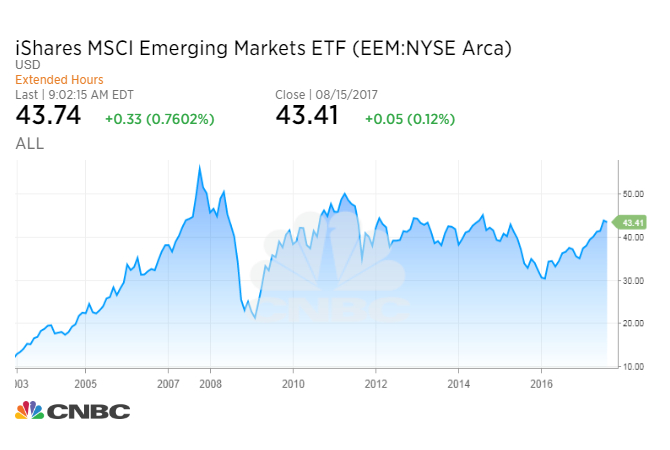Emerging market stocks look ready to run higher, going by chart analysis and economic fundamentals, according to a long-time investor.
Tim Seymour, managing partner at Triogem Asset Management, pointed out that in the last week, the relative performance of the iShares MSCI emerging markets ETF — EEM — to the S&P 500 hit its highest level in nearly two years.
That “to me is indicative of a breakout of a two-year range,” said Seymour, who is also the founder of EmergingMoney.com and a CNBC contributor.
Emerging markets include China, Brazil, Russia, India and countries in southeast Asia. Helped by more stable oil prices and a weaker U.S. dollar, the benchmark EEM broke a three-year losing streak in 2016 and is up 25 percent this year, on pace for its best year since 2009.
“Right now EM has [the] best of both worlds: low rates, and low inflation and increasing growth,” Seymour said. “Fund flows are sympathetic to this backdrop and are in no way stretched relative to where global allocations can still go.”
Investors have poured at least $1 billion or more into emerging market stocks in each of the last four weeks, according to EPFR Global. That marks 21-straight weeks of inflows through the week ended Aug. 9, the data showed.
However, the latest recovery in fund flows for emerging market stocks is still $55 billion short of bringing net flows back to 2014 levels, according to EPFR.
The 52-week high in EEM is also 25 percent below its all-time high of 55.83 touched in October 2007. In contrast, the S&P 500 trades about 1 percent from its all-time high.
The 8 percent drop in the U.S. dollar index on the slower-than-expected pace of Federal Reserve tightening is also a major factor in the emerging market stocks’ strong gains. Many emerging market countries hold large amounts of dollar-denominated debt, and a weaker dollar makes those debts less costly to pay off.
But this time, analysts note economic fundamentals and technological developments are contributing to the rally as well.
Patterns of emerging market stocks’ internal outperformance during periods of dollar weakness has been “significantly disrupted during the 2017 dollar decline,” Geoff Dennis, head of global emerging market equity strategy at UBS, said in an Aug. 7 note. “The biggest disrupter in 2017 to the normal pattern of relative sector performance at times of dollar weakness has been the very strong rally in IT.”
Dennis pointed out that emerging markets information technology stocks were up 43 percent for the year through July, versus emerging markets’ 23.7 percent gain over that time.
Even among U.S.-listed technology stocks, some of the best performers have been Chinese tech giants such as Alibaba and NetEase.
“You do have extraordinary growth” in emerging markets, Seymour said. “You do have tech that’s leapfrogging other kind of legacy systems, and I think frankly you have more and more sophisticated central bankers and financial ministers In every EM economy in the world.”
Most importantly, China’s economy is stabilizing and the country’s corporate earnings are growing.
“China’s a very important part of this. If you don’t believe in China I think it’s going to be difficult to believe in EM,” Seymour said.
The country’s stocks have the greatest weighting in the MSCI emerging markets index at nearly 29 percent. This year, MSCI also finally said it would include some of the mainland Chinese-traded stocks in the benchmark index.
IShares MSCI Emerging Markets ETF (EEM) performance from 2003 – 2017

The International Monetary Fund on Tuesday revised its estimate for Chinese economic growth in 2017 to 6.7 percent from 6.2 percent this year. For the next four years, the IMF raised its average growth forecast for China to 6.4 percent from 6 percent.
China’s Securities Times said that as of Tuesday, 615 companies listed on the Shanghai and Shenzhen exchanges have reported 20.9 percent year-on-year earnings growth in the first half of the year to 146.08 billion yuan ($21.8 billion).
“We’ve not had it this good in the last six or seven years,” said June Chua, portfolio manager at Hong Kong-based Harvest Global Investments, which had $114.25 billion in assets under management at the end of March. “It’s the first time in a while we’ve had a sustained earnings recovery. I think if this trend can continue it can actually be a case of China gaining international attention again and gathering flows in terms of global asset allocation.”
To be sure, worries persist about how China’s debt-fueled growth may be unsustainable.
There is also still the chance the Federal Reserve could raise interest rates more quickly than markets expect, strengthening the U.S. dollar and increasing pressure on emerging markets.
“The biggest risks are that central banks move too quickly,” Seymour said.
Emerging market stocks may be set to break out after struggling for five years